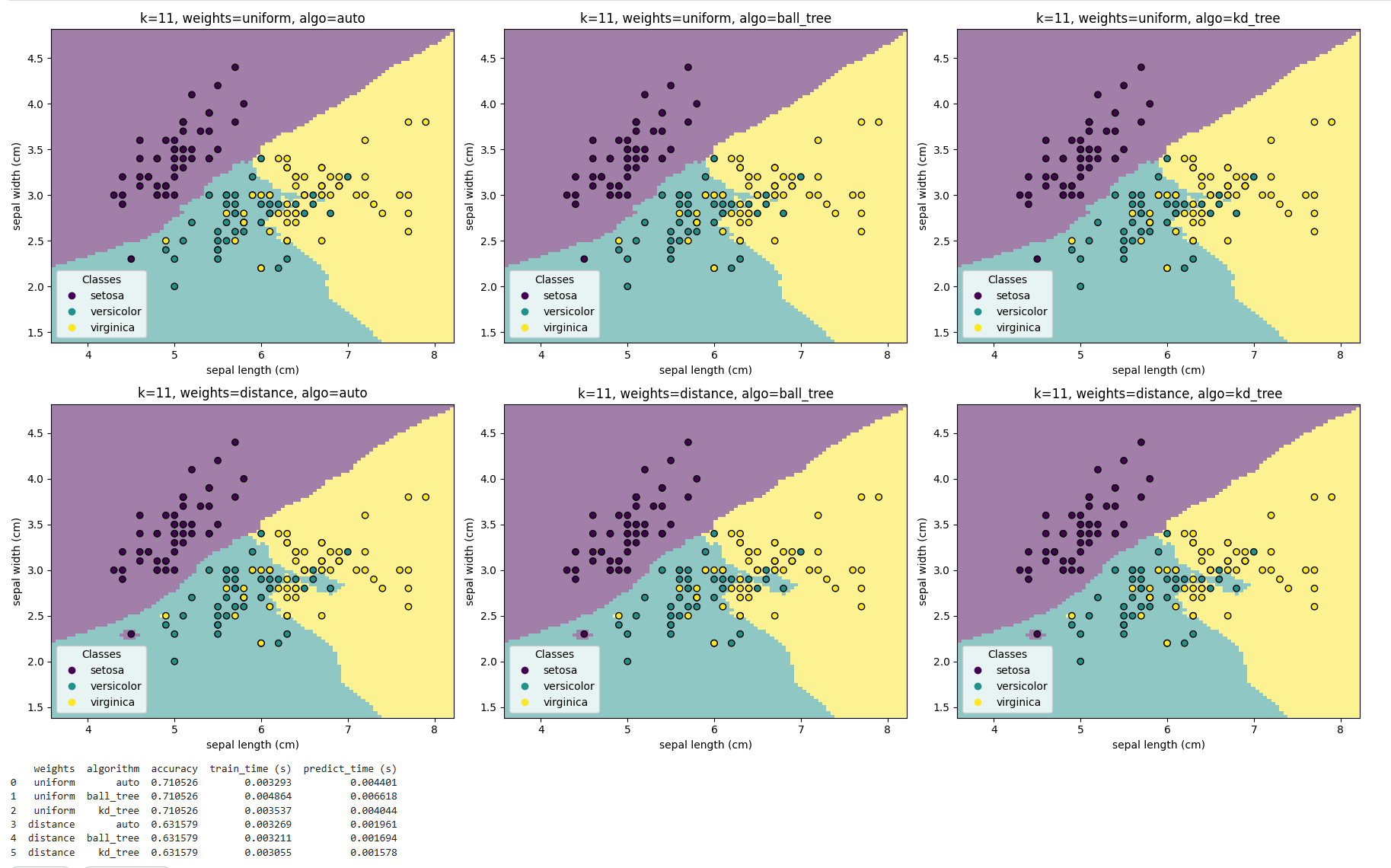K近邻:从理论到实践
K近邻:从理论到实践
文章目录
- K近邻:从理论到实践
- 1. 核心思想
- 2. 距离度量
- 3. k的选择与误差分析
- 3.1 近似误差
- 3.2 估计误差
- 3.3 总误差
- 4. kd树的构造与搜索
- 4.1 kd树的构造
- 4.2 kd树的搜索
- 5. 总结
- 6. K近邻用于iris数据集分类
- 6.1加载数据
- 6.2加载模型并可视化
1. 核心思想
K近邻(KNN)是一种基于实例的监督学习方法。其基本思想是:
对于一个待分类样本,根据训练集中与其“距离”最近的 kk 个邻居的类别,通过投票或加权投票的方式决定该样本的类别。
数学表达:
设训练集为
D={(x1,y1),(x2,y2),…,(xn,yn)},xi∈Rd,yi∈{1,2,…,C}{D} = \{ (x_1,y_1), (x_2,y_2), \dots, (x_n,y_n) \}, \quad x_i \in \mathbb{R}^d, \; y_i \in \{1,2,\dots,C\}D={(x1,y1),(x2,y2),…,(xn,yn)},xi∈Rd,yi∈{1,2,…,C}
给定测试样本x,找到其最近的 kk 个邻居集合Nk(x){N}_k(x)Nk(x)。
预测类别为:
y^(x)=argmaxc∈{1,…,C}∑(xi,yi)∈Nk(x)1(yi=c)\hat{y}(x) = \arg\max_{c \in \{1,\dots,C\}} \sum_{(x_i,y_i) \in \mathcal{N}_k(x)} \mathbf{1}(y_i = c)y^(x)=argc∈{1,…,C}max(xi,yi)∈Nk(x)∑1(yi=c)
其中,1(⋅){1}(\cdot)1(⋅) 是指示函数。
如果采用加权投票(考虑距离远近),则为:
y^(x)=argmaxc∈{1,…,C}∑(xi,yi)∈Nk(x)1∥x−xi∥⋅1(yi=c)\hat{y}(x) = \arg\max_{c \in \{1,\dots,C\}} \sum_{(x_i,y_i) \in \mathcal{N}_k(x)} \frac{1}{\|x - x_i\|} \cdot \mathbf{1}(y_i = c)y^(x)=argc∈{1,…,C}max(xi,yi)∈Nk(x)∑∥x−xi∥1⋅1(yi=c)
2. 距离度量
KNN 依赖距离来衡量样本相似度。常见的度量方式有:
- 欧氏距离:
d(xi,xj)=∑l=1d(xi(l)−xj(l))2d(x_i, x_j) = \sqrt{\sum_{l=1}^d (x_i^{(l)} - x_j^{(l)})^2}d(xi,xj)=l=1∑d(xi(l)−xj(l))2
- 曼哈顿距离:
d(xi,xj)=∑l=1d∣xi(l)−xj(l)∣d(x_i, x_j) = \sum_{l=1}^d |x_i^{(l)} - x_j^{(l)}|d(xi,xj)=l=1∑d∣xi(l)−xj(l)∣
- 闵可夫斯基距离(推广形式):
d(xi,xj)=(∑l=1d∣xi(l)−xj(l)∣p)1/pd(x_i, x_j) = \left( \sum_{l=1}^d |x_i^{(l)} - x_j^{(l)}|^p \right)^{1/p}d(xi,xj)=(l=1∑d∣xi(l)−xj(l)∣p)1/p
3. k的选择与误差分析
KNN 的性能对 k 值选择敏感,体现了 近似误差 与 估计误差 的权衡。
3.1 近似误差
- 定义:模型表达能力不足,导致预测结果无法逼近真实分布。
- k 较大时:决策边界过于平滑,难以捕捉复杂模式 → 近似误差大。
- k 较小时:决策边界灵活,可以更好地拟合真实模式 → 近似误差小。
数学上,假设真实函数为 f(x),KNN 的期望预测为:
f^(x)=ED[y^(x)]\hat{f}(x) = \mathbb{E}_{\mathcal{D}}[\hat{y}(x)]f^(x)=ED[y^(x)]
则近似误差为:
Bias2(x)=(ED[y^(x)]−f(x))2\text{Bias}^2(x) = \big( \mathbb{E}_{\mathcal{D}}[\hat{y}(x)] - f(x) \big)^2Bias2(x)=(ED[y^(x)]−f(x))2
3.2 估计误差
- 定义:模型对有限训练数据过于依赖,泛化性差,导致预测不稳定。
- k 较小时:极易受噪声点影响,估计误差大。
- k 较大时:结果受单个点波动影响小,估计误差小。
其数学形式为:
Var(x)=ED[(y^(x)−ED[y^(x)])2]\text{Var}(x) = \mathbb{E}_{\mathcal{D}}\big[(\hat{y}(x) - \mathbb{E}_{\mathcal{D}}[\hat{y}(x)])^2\big]Var(x)=ED[(y^(x)−ED[y^(x)])2]
3.3 总误差
textMSE(x)=Bias2(x)+Var(x)+σ2text{MSE}(x) = \text{Bias}^2(x) + \text{Var}(x) + \sigma^2textMSE(x)=Bias2(x)+Var(x)+σ2
其中,σ2\sigma^2σ2 是不可约误差。
因此,选择合适的 k 值非常重要。
4. kd树的构造与搜索
由于 KNN 需要计算测试点与所有训练点的距离,时间复杂度为O(n)。为了加速,可以用 kd树进行近邻搜索。
4.1 kd树的构造
- kd树是一种对数据进行递归二分的空间划分结构。
- 每次选择一个维度(通常是方差最大的维度),按照该维度的中位数划分数据。
- 构造过程:
- 从根节点开始,选择一个维度作为切分轴;
- 找到该维度的中位数,作为节点存储值;
- 左子树存储小于该值的样本,右子树存储大于该值的样本;
- 递归进行直到样本数过少或树深度达到限制。
伪代码:
function build_kd_tree(points, depth):
if points is empty:
return None
axis = depth mod d
sort points by axis
median = len(points) // 2
node = new Node(points[median])
node.left = build_kd_tree(points[:median], depth+1)
node.right = build_kd_tree(points[median+1:], depth+1)
return node
4.2 kd树的搜索
kd树搜索遵循“回溯+剪枝”原则:
- 从根节点开始,递归到叶子节点,找到测试点所属的区域;
- 以该叶子节点为“当前最近邻”;
- 回溯检查父节点和另一子树,若另一子树中可能存在更近邻,则递归进入;
- 维护一个大小为 kk 的优先队列,存储当前最近的 kk 个邻居;
- 搜索结束时队列中的点即为近邻结果。
伪代码:
function knn_search(node, target, k, depth):
if node is None:
return
axis = depth mod d
if target[axis] < node.point[axis]:
next = node.left
other = node.right
else:
next = node.right
other = node.left
function knn_search(node, target, k, depth):if node is None:returnaxis = depth mod dif target[axis] < node.point[axis]:next = node.leftother = node.rightelse:next = node.rightother = node.leftknn_search(next, target, k, depth+1)update priority queue with node.pointif |target[axis] - node.point[axis]| < current_max_distance_in_queue:knn_search(other, target, k, depth+1)
5. 总结
- 核心思想:KNN 通过寻找最近的 kk 个邻居来分类或回归。
- k 的选择:小 kk → 近似误差小、估计误差大(过拟合);大 kk → 近似误差大、估计误差小(欠拟合)。
- kd树:通过空间划分加速近邻搜索,提升算法效率。
最终,KNN 的关键在于 合适的 k 值选择 和 高效的搜索结构。
6. K近邻用于iris数据集分类
6.1加载数据
from sklearn.datasets import load_iris
from sklearn.model_selection import train_test_splitiris = load_iris(as_frame=True)
X = iris.data[["sepal length (cm)", "sepal width (cm)"]]
y = iris.target
X_train, X_test, y_train, y_test = train_test_split(X, y, stratify=y, random_state=0)
鸢尾花数据集,as_frame=True 表示返回 pandas DataFrame 而不是 numpy 数组,方便做列选择。
这个数据集有 150 条样本,4 个特征:sepal length, sepal width, petal length, petal width。目标变量 target 有三类 (0=setosa, 1=versicolor, 2=virginica)。
6.2加载模型并可视化
import matplotlib.pyplot as plt
from sklearn.datasets import load_iris
from sklearn.model_selection import train_test_split
from sklearn.neighbors import KNeighborsClassifier
from sklearn.pipeline import Pipeline
from sklearn.preprocessing import StandardScaler
from sklearn.inspection import DecisionBoundaryDisplay
import pandas as pd
import time# 1. 载入数据
iris = load_iris(as_frame=True)
X = iris.data[["sepal length (cm)", "sepal width (cm)"]]
y = iris.target
X_train, X_test, y_train, y_test = train_test_split(X, y, stratify=y, random_state=0
)# 2. 构建 pipeline:标准化 + KNN
clf = Pipeline(steps=[("scaler", StandardScaler()),("knn", KNeighborsClassifier(n_neighbors=11))]
)# 3. 不同的 weights 和 algorithm 组合
weights_list = ["uniform", "distance"]
algorithms = ["auto", "ball_tree", "kd_tree"]# 定义结果存储表
results = []# 4. 画图:每行一个 weights,每列一个 algorithm
fig, axs = plt.subplots(nrows=len(weights_list), ncols=len(algorithms), figsize=(18, 10)
)for i, weights in enumerate(weights_list):for j, algo in enumerate(algorithms):ax = axs[i, j]# 设置参数并拟合start_train = time.time()clf.set_params(knn__weights=weights, knn__algorithm=algo).fit(X_train, y_train)end_train = time.time()start_pred = time.time()clf.predict(X_test)end_pred = time.time()acc = clf.score(X_test, y_test)results.append({"weights": weights,"algorithm": algo,"accuracy": acc,"train_time (s)": end_train - start_train,"predict_time (s)": end_pred - start_pred})# 决策边界disp = DecisionBoundaryDisplay.from_estimator(clf,X_test,response_method="predict",plot_method="pcolormesh",xlabel=iris.feature_names[0],ylabel=iris.feature_names[1],shading="auto",alpha=0.5,ax=ax,)# 训练样本点scatter = disp.ax_.scatter(X.iloc[:, 0], X.iloc[:, 1], c=y, edgecolors="k")# 图例disp.ax_.legend(scatter.legend_elements()[0],iris.target_names,loc="lower left",title="Classes",)# 子图标题ax.set_title(f"k={clf[-1].n_neighbors}, weights={weights}, algo={algo}")plt.tight_layout()
plt.show()
df_results = pd.DataFrame(results)
print(df_results)

weights algorithm accuracy train_time (s) predict_time (s)
0 uniform auto 0.710526 0.003293 0.004401
1 uniform ball_tree 0.710526 0.004864 0.006618
2 uniform kd_tree 0.710526 0.003537 0.004044
3 distance auto 0.631579 0.003269 0.001961
4 distance ball_tree 0.631579 0.003211 0.001694
5 distance kd_tree 0.631579 0.003055 0.001578
不同 algorithm 的表现
auto、ball_tree、kd_tree在相同权重下的 准确率完全一致,训练预测速度不同,这说明 搜索算法仅影响计算效率,不会改变最终分类结果。- 这和理论一致:算法只是用不同的数据结构加速邻居查找,不会影响邻居集合本身。
不同 weights 的表现
uniform权重下,测试集准确率为 71.05%;distance权重下,测试集准确率为 63.16%;- 在本实验中,uniform 明显优于 distance。
- 这表明在鸢尾花数据的 前两个特征(花萼长、宽) 上,等权投票比加权投票更适合。可能原因是:
- 特征维度少,距离加权放大了噪声点或边界点的影响;
- 类别边界本身不完全线性,用距离权重反而削弱了多数邻居的稳定性。
结合可视化
-
从决策边界图上可以看到:
uniform的边界相对平滑,更符合数据整体分布;
eights 的表现**
-
uniform权重下,测试集准确率为 71.05%; -
distance权重下,测试集准确率为 63.16%; -
在本实验中,uniform 明显优于 distance。
-
这表明在鸢尾花数据的 前两个特征(花萼长、宽) 上,等权投票比加权投票更适合。可能原因是:
- 特征维度少,距离加权放大了噪声点或边界点的影响;
- 类别边界本身不完全线性,用距离权重反而削弱了多数邻居的稳定性。
